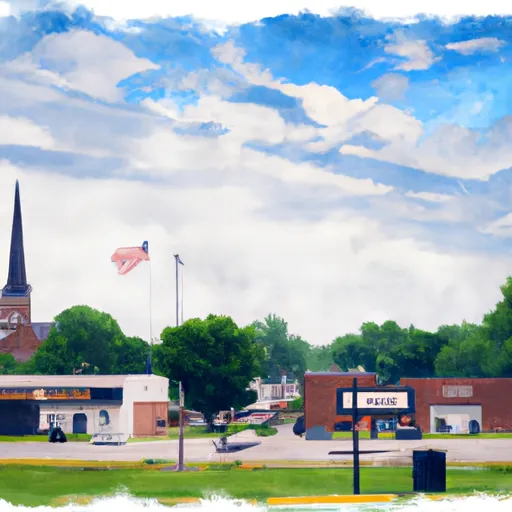-
 Snoflo Premium
Snoflo Premium
Get unlimited access to all our content
With no Ad interruptions! - Start Your Free Trial Login with existing account
Hope
Eden Index
Climate
8.3
•
Recreation
2.8
•
Community
1.6
•
Safeguard
4.7/10

Hope, Indiana is a small town located in Bartholomew County, in the central part of the state. The climate in Hope is generally temperate, with hot summers and cold winters. The average high temperatures in summer range from the mid-80s to low 90s°F, while winter temperatures average in the mid-30s to low 40s°F. Precipitation is fairly evenly distributed throughout the year, with an average of 42 inches of rainfall annually.
As for hydrological constituents, Hope is situated near the East Fork of the White River, which provides a vital water source for the area. The river's tributaries contribute to the hydrology of the region, sustaining the local ecosystem and supporting various aquatic species.
Outdoor recreation opportunities in Hope are abundant. The town is surrounded by picturesque countryside, offering opportunities for hiking, biking, and camping. The nearby Yellowwood State Forest provides over 23,000 acres of natural beauty, where visitors can enjoy activities such as fishing, boating, and wildlife viewing. Additionally, Hope is home to numerous parks and green spaces that offer opportunities for picnicking, sports, and leisurely walks. With its favorable climate and proximity to nature, Hope is an ideal destination for outdoor enthusiasts seeking relaxation and adventure.
What is the Eden Index?
The Snoflo Eden Index serves as a comprehensive rating system for regions, evaluating their desirability through a holistic assessment of climate health, outdoor recreation opportunities, and natural disaster risk, acknowledging the profound impact of these factors on livability and well-being.
Climate Health Indicator (CHI): 8.3
Hope receives approximately
1123mm of rain per year,
with humidity levels near 81%
and air temperatures averaging around
12°C.
Hope has a plant hardyness factor of
6, meaning
plants and agriculture in this region thrive during a short period during spring and early summer. Most
plants will die off during the colder winter months.
By considering the ideal temperature range, reliable water supplies, clean air, and stable seasonal rain or snowpacks, the Climate Health Indicator (CHI) underscores the significance of a healthy climate as the foundation for quality living.
A healthy climate is paramount for ensuring a high quality of life and livability in a region, fostering both physical well-being and environmental harmony. This can be characterized by ideal temperatures, reliable access to water supplies, clean air, and consistent seasonal rain or snowpacks.
Weather Forecast
Streamflow Conditions
Patoka-White
Area Rivers
Patoka-White
Snowpack Depths
Patoka-White
Reservoir Storage Capacity
Patoka-White
Groundwater Levels
Recreational Opportunity Index (ROI): 2.8
The Recreational Opportunity Index (ROI) recognizes the value of outdoor recreational options, such as parks, hiking trails, camping sites, and fishing spots, while acknowledging that climate plays a pivotal role in ensuring the comfort and consistency of these experiences.
Access to outdoor recreational opportunities, encompassing activities such as parks, hiking, camping, and fishing, is crucial for overall well-being, and the climate plays a pivotal role in enabling and enhancing these experiences, ensuring that individuals can engage in nature-based activities comfortably and consistently.
Camping Areas
| Campground | Campsites | Reservations | Toilets | Showers | Elevation |
|---|---|---|---|---|---|
| Salt River Rec Area | None | 428 ft | |||
| White River Campground | 106 | 774 ft | |||
| Charlestown State Park | 190 | 616 ft | |||
| Mississinewa Lake - Miami Recreation Area | 430 | 764 ft | |||
| Heflen Co Park | None | 639 ft | |||
| Deam Lake State Rec Area | 185 | 533 ft | |||
| Hardy Lake State Rec Area | 170 | 650 ft | |||
| Clark State Forest | 45 | 851 ft | |||
| Irwin City Park | 12 | 662 ft | |||
| Muscatatuck | 35 | 718 ft |
Nearby Ski Areas
Catastrophe Safeguard Index (CSI):
The Catastrophe Safeguard Index (CSI) recognizes that natural disaster risk, encompassing floods, fires, hurricanes, and tornadoes, can drastically affect safety and the overall appeal of an area.
The level of natural disaster risk in a region significantly affects safety and the overall livability, with climate change amplifying these risks by potentially increasing the frequency and intensity of events like floods, fires, hurricanes, and tornadoes, thereby posing substantial challenges to community resilience and well-being.
Community Resilience Indicator (CRI): 1.6
The Community Resilience Indicator (CRI) recognizes that education, healthcare, and socioeconomics are crucial to the well-being of a region. The CRI acknowledges the profound impact of these elements on residents' overall quality of life. By evaluating educational resources, healthcare accessibility, and economic inclusivity, the index captures the essential aspects that contribute to a thriving community, fostering resident satisfaction, equity, and social cohesion.

